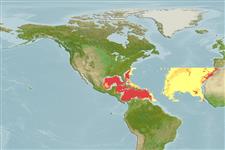>
Notacanthiformes (Halosaurs and deep-sea spiny eels) >
Halosauridae (Halosaurs)
Etymology: Aldrovandia: Taken from Ulisse Aldrovandi, (1522-1605), a Renaissance naturalist and physician noted by his systematic and accurate observations of plants and animals (Ref. 45335).
More on authors: Goode & Bean.
Environment: milieu / climate zone / depth range / distribution range
Ecologie
marien bathypelagisch; diepte 460 - 2560 m (Ref. 4448). Deep-water; 36°N - 9°N
Eastern Atlantic: Western Sahara to Sierra Leone. Western Atlantic: Virginia, USA to the Lesser Antilles, mainly the Gulf of Mexico and Caribbean. The only record off Nova Scotia is doubtful.
Grootte / Gewicht / Leeftijd
Maturity: Lm ? range ? - ? cm
Max length : 55.0 cm TL mannelijk / geslacht onbekend; (Ref. 4448)
Korte beschrijving
Morfologie | Morfometrie
Few gill rakers on the 1st branchial arch. Short maxillary spine and the broad and scaleless interorbital region. Peculiar structure of lateral line. Grayish white in color (Ref. 37108).
Found on the continental slope and rise. Feeds mainly on benthic organisms which includes pelecypods, amphipods, mysids, polychaetes and ophiuroids (Ref. 4448).
Levenscyclus en paargedrag
Maturiteit | Voortplanting | Paaien | Eieren | Fecunditeit | Larven
Sulak, K.J., 1990. Halosauridae. p. 126-132. In J.C. Quero, J.C. Hureau, C. Karrer, A. Post and L. Saldanha (eds.) Check-list of the fishes of the eastern tropical Atlantic (CLOFETA). JNICT, Lisbon; SEI, Paris; and UNESCO, Paris. Vol. 1. (Ref. 4448)
Status op de Rode Lijst van het IUCN (Ref. 130435)
Gevaar voor de mens
Harmless
Gebruik door de mens
Meer informatie
Lokale namenSynoniemenMetabolismePredatorenEcotoxicologieVoortplantingMaturiteitPaaienPaaiaggregatiesFecunditeitEierenOntwikkeling van de eieren
Leeftijd/GrootteGroeiLengte-gewichtLengte-lengteLengtefrequentiesMorfometrieMorfologieLarvenLarvale populatiedynamiekRekruteringAbundantieBRUVS
ReferentiesAquacultuurAquacultuurprofielKweeklijnenGeneticaElectrophoresesErfelijkheidZiektesVerwerkingNutrientsMassaconversie
Tools
Speciale rapporten
Download XML
Internetbronnen
Estimates based on models
Preferred temperature (Ref.
123201): 4.4 - 9.5, mean 5.4 °C (based on 237 cells).
Fylogenetische diversiteitsindex (Ref.
82804): PD
50 = 0.5156 [Uniqueness, from 0.5 = low to 2.0 = high].
Bayesian length-weight: a=0.00087 (0.00033 - 0.00229), b=3.07 (2.84 - 3.30), in cm total length, based on LWR estimates for this (Sub)family-body shape (Ref.
93245).
Trofisch niveau (Ref.
69278): 3.3 ±0.40 se; based on food items.
Weerstandsvermogen (Ref.
120179): Gemiddeld, minimale populatieverdubbelingstijd 1,4-4,4 jaar (Preliminary K or Fecundity.).
Fishing Vulnerability (Ref.
59153): Moderate vulnerability (42 of 100).
